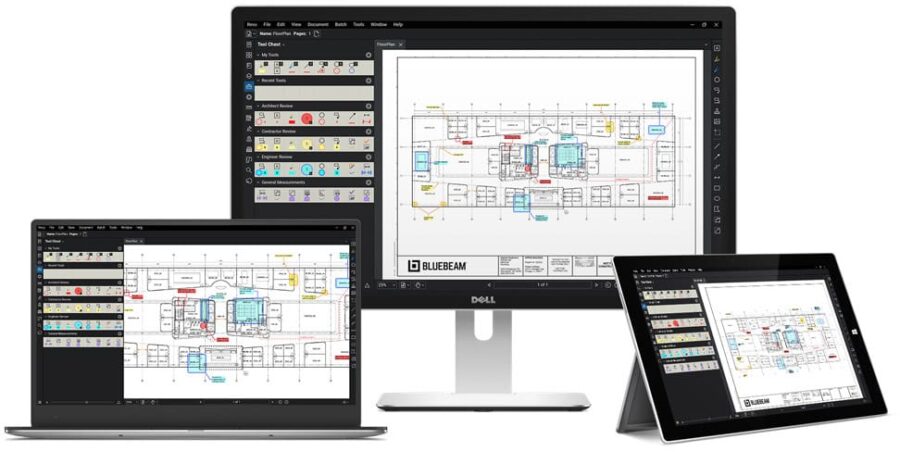Bluebeam Revu is a best-in-class PDF markup and collaboration software tool developed by Bluebeam in 2002. It is used by architects, engineers, construction workers, specialist contractors and quantity surveyors to gather and assess data and information throughout the lifecycle of a building project.
Construction industry workers face a range of challenges as they seek to bring projects to completion. Revu can help overcome any number of these by using PDFs, the open file format that everyone in the industry can use and access (see below).
Revu tools have been specifically curated for the construction, architecture and engineering industry to do their jobs better and more efficiently.
Easy to use
The software is easy to use, reliable and proven to be cost-effective. Research suggests using Revu can yield 60% time savings on design reviews, more than 80% faster quantities and estimations and enabling 90% faster snagging reports.
While a growing number of U.K. companies are using Revu, in the U.S. it has been used for years, saving customers time, creating efficiencies and generally handing companies the ability to do more, do it better and do it faster.
Take Professional Underground Services (PUS), a utility installations company based in Oregon.
Specialising in green solutions, the firm got a call to upgrade the water services infrastructure to 147 mobile homes on a nearby mobile homes estate.
Records of the existing water lines were incomplete, but by using Revu’s overlay feature, PUS was able to trace the route of the existing network and kickstart revamping the system.
Using Revu’s markup features, PUS could denote where pavements were, where to place appropriate signage, where to install hot taps and blowout valves, where to do boring, and which lines would be service lines and which would be lateral lines.
A job that could have taken an engineering firm between six and nine months to complete was finished in just three months. “Without Revu, the project wouldn’t have been able to get done at all,” said Nathaniel Wilson, an assistant project manager at PUS.
Workflows for every job on a building project
Revu touches every phase of a project: from setup to design review, tender review and site logistics, to defect inspections, project handover and facilities management. It enables people all over the world—and across time zones—to view and mark up a document together simultaneously, as if they were sitting around a table in the same room.
A key aspect of Revu is that data can be edited, organised and managed with Bluebeam software. The integrated Mark-ups List offers the functionality of a spreadsheet, such as Microsoft Excel, inside the PDF file, giving users the ability to filter markups by subject, sort notes, assign responsibilities and create their own customised templates.
Since this extra data is stored within the framework of the PDF file format, it can be manipulated and managed. Revu exploits this, allowing users to maximise productivity, increase project predictability and reduce risk to a minimum.
Revu has been specifically built and designed to meet the needs of the construction industry, as its built-in tools and functions provide users with what they need to do their jobs faster and more efficiently.
For more technical users, Revu has more features and greater functionality designed for specific workflows, with tool sets, visual search, compare documents and batched hyperlinking being prime examples. It’s because of these industry-specific tools that many construction industry professionals switch to Revu as their default software.
Users can customise interface and user profiles, creating a standardised tool chest to save regularly used markup tools and industry-specific icons and comparing documents by overlaying drawings and easily identifying any changes. The Mark-ups List also helps to keep track of all comments and markups noted on plans to ensure users can sort, filter and have full transparency of who did what, when and where.
There is also AutoMark, which allows users to automatically rename all page labels by using bookmarks or a page region, plus 2D and 3D PDF creation plugins to integrate with design software.
Studio in Revu allows users to easily invite team members from anywhere in the world to securely collaborate in real time, providing a centralised place for project teams to create, review, annotate, modify and update the same files at the same time.
Studio Sessions allows up to 500 simultaneous users to be able to comment and participate in any plan, which speeds up communication across the supply chain. Even partners who don’t own a copy of Revu can access and use the software to participate on projects, keeping work on time and budget and helping teams stay aligned.

Customer experience
Many firms have benefited from adopting Bluebeam Revu. Dublin-based ClearTech Engineered Solutions started using the system to speed up its project estimations and ended up cutting design review times in half.
Document comparisons used to take half a day, whereas using Revu the company has whittled this down to a mere 25 minutes.
ClearTech’s return on its investment in Bluebeam has also been impressive, with business growing by 50% after going digital. Costs can be more easily tracked, speeding up the ability to deliver accurate and timely quotes for jobs.
The firm also uses Revu to set key performance indicators (KPIs) for engineers on site to track how long each task requires.
ClearTech chief executive Feargal Cleary said using Revu meant his firm was able to get “accurate understanding of what we’re using on site, what’s being used, what’s required and what we need to order. We use that insight in the office to create our orders to look ahead”.
What is in Bluebeam Revu
Revu comes in three editions to suit the needs of a variety of design and construction workflows.
Revu Standard. The essential solution for intuitive 2D and 3D PDF markup, editing and collaboration, Revu Standard features 2D/3D PDF annotation, markups list, tool chest, the ability to compare documents and the measurement tool.
Revu CAD. As well as the standard features, Revu CAD includes plugins for 2D and 3D PDFs and batch creation.
Revu eXtreme. Bluebeam’s “blue ribbon” system Revu eXtreme has both standard and Revu CAD features, plus automatic form creation, batch link, batch slip sheet, OCR, batch sign and seal, and quantity link.
Added value
By using Revu and going digital, construction industry professionals can create significant improvements across their workflows, maximising productivity, reducing risk and rework, and improving project predictability. Revu keeps teams on the same page through the design process, helping move the project forward during construction and preserves important project data through handover, providing critical accountability every step of the way.
And since Revu is an easy-to-adopt and scale solution for companies looking to begin their digital journey, teams can be up and running with minimal training, and they’ll be able to experience noticeable results including increased workflow efficiencies, higher productivity, improved decision-making, increased accountability and significant time and money savings.
And thanks to Studio in Revu, project participants can collaborate in real time, able to access and work on the same plans from anywhere in the world.
In addition, Bluebeam is continually developing and evolving its products based on customer feedback.
There is even a handy product suggestion feature where customers can request new elements to be integrated into products—all part of Bluebeam’s drive to offer a best-in-class service at all times.
To find the edition that’s right for you, explore Bluebeam’s helpful product selector.











